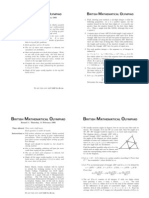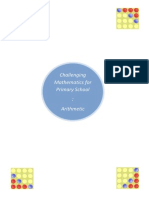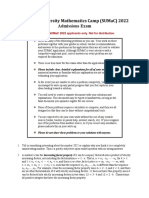0 ratings0% found this document useful (0 votes)
90 viewsBritish Mathematical Olympiad 30
British Mathematical Olympiad 30
Uploaded by
SempiternalThe document is the instructions and problems for the British Mathematical Olympiad Round 2 exam. It provides details on the structure of the exam, including that it is 3.5 hours long with 4 problems worth 10 marks each. Full solutions must be shown, and the best submissions will be thorough solutions to 1-2 problems rather than partial attempts at all 4. The top performers will be invited to further training opportunities culminating in the UK team for the International Mathematical Olympiad.
Copyright:
Attribution Non-Commercial (BY-NC)
Available Formats
Download as PDF, TXT or read online from Scribd
British Mathematical Olympiad 30
British Mathematical Olympiad 30
Uploaded by
Sempiternal0 ratings0% found this document useful (0 votes)
90 views1 pageThe document is the instructions and problems for the British Mathematical Olympiad Round 2 exam. It provides details on the structure of the exam, including that it is 3.5 hours long with 4 problems worth 10 marks each. Full solutions must be shown, and the best submissions will be thorough solutions to 1-2 problems rather than partial attempts at all 4. The top performers will be invited to further training opportunities culminating in the UK team for the International Mathematical Olympiad.
Original Description:
cek
Copyright
© Attribution Non-Commercial (BY-NC)
Available Formats
PDF, TXT or read online from Scribd
Share this document
Did you find this document useful?
Is this content inappropriate?
The document is the instructions and problems for the British Mathematical Olympiad Round 2 exam. It provides details on the structure of the exam, including that it is 3.5 hours long with 4 problems worth 10 marks each. Full solutions must be shown, and the best submissions will be thorough solutions to 1-2 problems rather than partial attempts at all 4. The top performers will be invited to further training opportunities culminating in the UK team for the International Mathematical Olympiad.
Copyright:
Attribution Non-Commercial (BY-NC)
Available Formats
Download as PDF, TXT or read online from Scribd
Download as pdf or txt
0 ratings0% found this document useful (0 votes)
90 views1 pageBritish Mathematical Olympiad 30
British Mathematical Olympiad 30
Uploaded by
SempiternalThe document is the instructions and problems for the British Mathematical Olympiad Round 2 exam. It provides details on the structure of the exam, including that it is 3.5 hours long with 4 problems worth 10 marks each. Full solutions must be shown, and the best submissions will be thorough solutions to 1-2 problems rather than partial attempts at all 4. The top performers will be invited to further training opportunities culminating in the UK team for the International Mathematical Olympiad.
Copyright:
Attribution Non-Commercial (BY-NC)
Available Formats
Download as PDF, TXT or read online from Scribd
Download as pdf or txt
You are on page 1of 1
Supported by
Supported by
British Mathematical Olympiad
Round 2 : Tuesday, 30 January 2007 Time allowed Three and a half hours. Each question is worth 10 marks. Instructions Full written solutions - not just answers - are required, with complete proofs of any assertions you may make. Marks awarded will depend on the clarity of your mathematical presentation. Work in rough rst, and then draft your nal version carefully before writing up your best attempt. Rough work should be handed in, but should be clearly marked. One or two complete solutions will gain far more credit than partial attempts at all four problems. The use of rulers and compasses is allowed, but calculators and protractors are forbidden. Staple all the pages neatly together in the top left hand corner, with questions 1,2,3,4 in order, and the cover sheet at the front. In early March, twenty students will be invited to attend the training session to be held at Trinity College, Cambridge (29th March - 2nd April). At the training session, students sit a pair of IMO-style papers and 8 students will be selected for further training. Those selected will be expected to participate in correspondence work and to attend further training. The UK Team of six for this summers International Mathematical Olympiad (to be held in Hanoi, Vietnam 23-31 July) will then be chosen. Do not turn over until told to do so.
2006/7 British Mathematical Olympiad Round 2
1. Triangle ABC has integer-length sides, and AC = 2007. The internal bisector of BAC meets BC at D. Given that AB = CD, determine AB and BC . 2. Show that there are innitely many pairs of positive integers (m, n) such that m+1 n+1 + n m is a positive integer. 3. Let ABC be an acute-angled triangle with AB > AC and BAC = 60o . Denote the circumcentre by O and the orthocentre by H and let OH meet AB at P and AC at Q. Prove that P O = HQ. Note: The circumcentre of triangle ABC is the centre of the circle which passes through the vertices A, B and C . The orthocentre is the point of intersection of the perpendiculars from each vertex to the opposite side. 4. In the land of Hexagonia, the six cities are connected by a rail network such that there is a direct rail line connecting each pair of cities. On Sundays, some lines may be closed for repair. The passengers rail charter stipulates that any city must be accessible by rail from any other (not necessarily directly) at all times. In how many dierent ways can some of the lines be closed subject to this condition?
You might also like
- British Mathematical Olympiad 1993 2007Document30 pagesBritish Mathematical Olympiad 1993 2007orangeskidNo ratings yet
- Euclid Combined ContestDocument89 pagesEuclid Combined ContestJun Yitt100% (1)
- International Competitions IMO Shortlist 2000 17Document6 pagesInternational Competitions IMO Shortlist 2000 17Berce GabrielNo ratings yet
- Journal 2019 1 and 2Document52 pagesJournal 2019 1 and 2ValentioNo ratings yet
- Usamo 2012: Day 1 - 24 April 2012Document2 pagesUsamo 2012: Day 1 - 24 April 2012SeanGeeNo ratings yet
- China China Girls Math Olympiad 2006Document2 pagesChina China Girls Math Olympiad 2006PremMehtaNo ratings yet
- The Olympic Mathematical Marathon Grades 7-12 Vol.1 - George ApostolopoulosDocument5 pagesThe Olympic Mathematical Marathon Grades 7-12 Vol.1 - George ApostolopoulosAndrei346No ratings yet
- Math Olympiad Problem Solving Stanford University Epgy Summer 2551081 PDFDocument2 pagesMath Olympiad Problem Solving Stanford University Epgy Summer 2551081 PDFAchmad KusumahNo ratings yet
- SMO 2009 Senior SolutionDocument16 pagesSMO 2009 Senior Solutionwmdsg100% (1)
- SMO 2007 Open SolutionDocument11 pagesSMO 2007 Open Solutionwmdsg100% (1)
- BulgarianMathematicalCompetitions2003 2006 PDFDocument221 pagesBulgarianMathematicalCompetitions2003 2006 PDFĐặng Quốc ThànhNo ratings yet
- Mock AMC BDocument4 pagesMock AMC BeisatoponNo ratings yet
- Third Round 1997 - 2010Document49 pagesThird Round 1997 - 2010Cristian MateiNo ratings yet
- KACY I 003 Booklet Olympiad Pre AlgebraDocument7 pagesKACY I 003 Booklet Olympiad Pre AlgebraTalal TariqNo ratings yet
- 2010 Maths PDFDocument23 pages2010 Maths PDFalmond2009No ratings yet
- Berkeley Math CircleDocument2 pagesBerkeley Math Circlehuymai54c0% (1)
- Primary Math Challenge ArithmeticDocument28 pagesPrimary Math Challenge ArithmeticSadi SnmzNo ratings yet
- Singapore and Asian Schools Math Olympiad (Sasmo) 2016 Primary 4Document36 pagesSingapore and Asian Schools Math Olympiad (Sasmo) 2016 Primary 4kanittiNo ratings yet
- Rioplatense Mathematical Olympiad, Level 3-2005Document2 pagesRioplatense Mathematical Olympiad, Level 3-2005OklaNo ratings yet
- Pre-Preparation Course Exam 2004-08 PDFDocument80 pagesPre-Preparation Course Exam 2004-08 PDFSoma BoseNo ratings yet
- The 55th International Mathematical Olympiad: Evan ChenDocument33 pagesThe 55th International Mathematical Olympiad: Evan ChenYunita Septriana AnwarNo ratings yet
- 2001Gauss7Solution PDFDocument10 pages2001Gauss7Solution PDFkarpeoNo ratings yet
- De HOMC 2006 2013Document35 pagesDe HOMC 2006 2013Ba SacNo ratings yet
- China China Girls Math Olympiad 2012Document2 pagesChina China Girls Math Olympiad 2012PremMehtaNo ratings yet
- UKJ M C: Ukmt Unior Athematical HallengeDocument4 pagesUKJ M C: Ukmt Unior Athematical HallengeHumaira MohungooNo ratings yet
- 2024 State Competition Sprint RoundDocument8 pages2024 State Competition Sprint Roundshimmiguel00No ratings yet
- USAMO 2005 Solution Notes: Compiled by Evan ChenDocument9 pagesUSAMO 2005 Solution Notes: Compiled by Evan ChenAndrei346No ratings yet
- 88 Kangaroo PK 2005 BenjaminDocument4 pages88 Kangaroo PK 2005 BenjaminSJK(C) THUNG HONNo ratings yet
- Intermediate Mathematical Challenge: InstructionsDocument4 pagesIntermediate Mathematical Challenge: InstructionsAch JohnNo ratings yet
- Bdmo Book ListDocument5 pagesBdmo Book ListPushan Paul50% (2)
- Mentoring: SolveDocument2 pagesMentoring: SolvePriyanshi Gupta 7C100% (1)
- China China Girls Math Olympiad 2008Document2 pagesChina China Girls Math Olympiad 2008PremMehtaNo ratings yet
- Gauss Contest Preparation-2Document7 pagesGauss Contest Preparation-2kheyNo ratings yet
- Events 1202 Mathematical Olympiad 2015 PDFDocument44 pagesEvents 1202 Mathematical Olympiad 2015 PDFYahooNo ratings yet
- Junior Mathematical Challenge: Tuesday 30 April 2019Document4 pagesJunior Mathematical Challenge: Tuesday 30 April 2019Add UpNo ratings yet
- 1998 Solutions Cayley Contest: Canadian Mathematics CompetitionDocument11 pages1998 Solutions Cayley Contest: Canadian Mathematics Competitionahmad RashidNo ratings yet
- SMO 2005 Senior SolutionDocument11 pagesSMO 2005 Senior SolutionwmdsgNo ratings yet
- 03 Wmi 2018 Final Poe (Plan B)Document1 page03 Wmi 2018 Final Poe (Plan B)Roni Asep wahyudiNo ratings yet
- Grade 5 Benjamin 1 Grade 5 PKDocument9 pagesGrade 5 Benjamin 1 Grade 5 PKMinh PhươngNo ratings yet
- 2015mockamc10 WithsolDocument9 pages2015mockamc10 Withsolapi-272546296No ratings yet
- British Mathematical Olympiad 1993-2016Document49 pagesBritish Mathematical Olympiad 1993-2016AxlBassiNo ratings yet
- 2004 AMC 12B ProblemsDocument5 pages2004 AMC 12B ProblemsjabagaweeNo ratings yet
- Kangoeroe WizBRAIN 2015 EngelsDocument5 pagesKangoeroe WizBRAIN 2015 EngelserikatsmaNo ratings yet
- Goucher - Mathematical Olympiad Dark ArtsDocument168 pagesGoucher - Mathematical Olympiad Dark ArtsmavrogiannisNo ratings yet
- Mathematical Olympiads: Enrique Trevi NoDocument27 pagesMathematical Olympiads: Enrique Trevi NoSilviu BogaNo ratings yet
- Question Booklet: Inter-School Mathematics Contest 2017 - Individual Event (Junior Section)Document9 pagesQuestion Booklet: Inter-School Mathematics Contest 2017 - Individual Event (Junior Section)Imam SyafiiNo ratings yet
- MCL 12.eDocument194 pagesMCL 12.eyingbingyou01No ratings yet
- JBMO ShortLists-2006Document1 pageJBMO ShortLists-2006OklaNo ratings yet
- Timetables and Distance TablesDocument11 pagesTimetables and Distance TablesJoel GrayNo ratings yet
- 2001 AMC 12 ProblemsDocument5 pages2001 AMC 12 ProblemsjabagaweeNo ratings yet
- JBMO ShortLists-2001Document2 pagesJBMO ShortLists-2001OklaNo ratings yet
- Angle Chasing - Junior: Thanom Shaw March 31 & April 1, 2021Document5 pagesAngle Chasing - Junior: Thanom Shaw March 31 & April 1, 2021BobNo ratings yet
- NSTC 9 Sample Paper 2011 13 V1Document24 pagesNSTC 9 Sample Paper 2011 13 V1M Nisar Chishti Hassan100% (1)
- Stanford University Mathematics Camp (Sumac) 2022 Admissions ExamDocument5 pagesStanford University Mathematics Camp (Sumac) 2022 Admissions ExamAjay NegiNo ratings yet
- British Mathematical Olympiad 2006/7 British Mathematical Olympiad Round 2Document1 pageBritish Mathematical Olympiad 2006/7 British Mathematical Olympiad Round 2Ajay NegiNo ratings yet
- British Mathematical Olympiad 1800Document1 pageBritish Mathematical Olympiad 1800SempiternalNo ratings yet
- BmolotDocument38 pagesBmolotDesmond MilesNo ratings yet
- Brittish Mathematical Olympiad - 1998-2003Document12 pagesBrittish Mathematical Olympiad - 1998-2003Guilherme RochaNo ratings yet
- Bmo2 2000Document1 pageBmo2 2000safeosundNo ratings yet
- British Mathematical Olympiad 32Document1 pageBritish Mathematical Olympiad 32SempiternalNo ratings yet
- JurnalDocument9 pagesJurnaljoyfull776No ratings yet
- Ayatullah Jawad Tehraani - XKP - Living The Right WayDocument81 pagesAyatullah Jawad Tehraani - XKP - Living The Right WaySempiternalNo ratings yet
- Where Do We Find God - Muhammad Legenhausen PDFDocument2 pagesWhere Do We Find God - Muhammad Legenhausen PDFSempiternalNo ratings yet
- AnimalFeedWksp Participants WebDocument2 pagesAnimalFeedWksp Participants WebSempiternalNo ratings yet
- Review of Peter Byrne, God and Realism PDFDocument16 pagesReview of Peter Byrne, God and Realism PDFSempiternalNo ratings yet
- Murtada Mutahhari - Ashura Misrepresentations and DistortionsDocument5 pagesMurtada Mutahhari - Ashura Misrepresentations and DistortionsSempiternalNo ratings yet
- A Closer Look at Christianity - Mohamed QasemDocument66 pagesA Closer Look at Christianity - Mohamed QasemSempiternalNo ratings yet
- Foucault's Pendulum and The Hermeneutics of Umberto EcoDocument11 pagesFoucault's Pendulum and The Hermeneutics of Umberto EcoSempiternalNo ratings yet
- Ibn Sīnā and Explicit QuantificationDocument3 pagesIbn Sīnā and Explicit QuantificationSempiternalNo ratings yet
- An Introduction To The Islamic Shariah - Sayyid Muhammad RizviDocument64 pagesAn Introduction To The Islamic Shariah - Sayyid Muhammad RizviSempiternalNo ratings yet
- Book Reviews - Kernel of The Kernel and Concerning The Wayfaring and Spiritual Journey of The People of IntellectDocument3 pagesBook Reviews - Kernel of The Kernel and Concerning The Wayfaring and Spiritual Journey of The People of IntellectSempiternalNo ratings yet
- Psychology of Learning From An Islamic PerspectiveDocument15 pagesPsychology of Learning From An Islamic PerspectiveSempiternal100% (1)
- Personality (Keirsey - Bates Inventory)Document10 pagesPersonality (Keirsey - Bates Inventory)SempiternalNo ratings yet
- How Does Who I Am Relate To High School and BeyondDocument8 pagesHow Does Who I Am Relate To High School and BeyondSempiternalNo ratings yet
- The Ontology of Time in Mulla Sadra's MetaphysicsDocument1 pageThe Ontology of Time in Mulla Sadra's MetaphysicsSempiternalNo ratings yet
- Non-Verbal Reasoning Sample TestDocument7 pagesNon-Verbal Reasoning Sample TestSempiternal100% (2)
- Personality Test ProjectDocument2 pagesPersonality Test ProjectSempiternalNo ratings yet
- Soul From The Perspective of Mulla Sadras Philosophy Edited by Seyed G SafaviDocument4 pagesSoul From The Perspective of Mulla Sadras Philosophy Edited by Seyed G SafaviSempiternalNo ratings yet
- Hans Eysenck's Personality TheoriesDocument4 pagesHans Eysenck's Personality TheoriesSempiternalNo ratings yet
- Career Development and Exploration Resources For K 8 (Updated January 2012)Document4 pagesCareer Development and Exploration Resources For K 8 (Updated January 2012)SempiternalNo ratings yet
- Career Research and Development II Essential Curriculum (Grade 12) (+FINANCIAL LITERACY)Document4 pagesCareer Research and Development II Essential Curriculum (Grade 12) (+FINANCIAL LITERACY)SempiternalNo ratings yet
- Academic Standards For Career Education and Work (Pennsylvania Department of Education)Document18 pagesAcademic Standards For Career Education and Work (Pennsylvania Department of Education)SempiternalNo ratings yet
- Course Code: MEC - 231 Course Title: Basic Mechanics-IDocument59 pagesCourse Code: MEC - 231 Course Title: Basic Mechanics-IAshik Rahman RifatNo ratings yet
- MATH-Q4-Week 1-LAS-1Document1 pageMATH-Q4-Week 1-LAS-1Robie Roza DamasoNo ratings yet
- Lesson 3 and 4 Hyperbola Non-Degenerate Equations (Midterm)Document28 pagesLesson 3 and 4 Hyperbola Non-Degenerate Equations (Midterm)cheezymozzarellaNo ratings yet
- MTH101: Calculus I Lecture 6: Differentiation Formulas: International Burch UniversityDocument17 pagesMTH101: Calculus I Lecture 6: Differentiation Formulas: International Burch Universitylu cucuNo ratings yet
- CBSE Sample Paper Class 7 Maths SA1 Set 3: Subject: Mathematics Class: Vii Max. Marks: 60 Duration: 2 HrsDocument3 pagesCBSE Sample Paper Class 7 Maths SA1 Set 3: Subject: Mathematics Class: Vii Max. Marks: 60 Duration: 2 HrsShalini AravindanNo ratings yet
- Pythagoras Revision QuizDocument2 pagesPythagoras Revision QuizVictoria YanNo ratings yet
- Aarushi Maths Questions STD VII KGMsetDocument12 pagesAarushi Maths Questions STD VII KGMsetKaushal Mahajan100% (1)
- Chapter 13 Surface Areas and VolumesDocument105 pagesChapter 13 Surface Areas and VolumesNitish MehraNo ratings yet
- 6 PAP International Mathematics Invitation Competition 2020 Primary 6 AnsDocument3 pages6 PAP International Mathematics Invitation Competition 2020 Primary 6 AnsJomar Ejedio100% (1)
- Forces in Equilibrium ExercisesDocument5 pagesForces in Equilibrium ExercisesayydenNo ratings yet
- Math 113 (Calculus II) Midterm Exam 1 SolutionsDocument10 pagesMath 113 (Calculus II) Midterm Exam 1 SolutionsGaladriel SotoNo ratings yet
- Answers For Topical Test Maths (7,8,9)Document9 pagesAnswers For Topical Test Maths (7,8,9)PremNo ratings yet
- WWW - Manaresults.co - In: Board Diploma Examination, (C-16) OCTOBER-2020 Deee-First Year ExaminationDocument3 pagesWWW - Manaresults.co - In: Board Diploma Examination, (C-16) OCTOBER-2020 Deee-First Year ExaminationNandan KumarNo ratings yet
- Surveying Volume 3 - B. C. Punmia, A. K. Jain and A. K. JainDocument74 pagesSurveying Volume 3 - B. C. Punmia, A. K. Jain and A. K. JainShashank Sathe33% (6)
- El 5Document3 pagesEl 5Anusha SinghalNo ratings yet
- Mathematics 4048/02: Preliminary Examination 2022Document26 pagesMathematics 4048/02: Preliminary Examination 2022قاتل مستأجرNo ratings yet
- Mathematics For Natural Sciences Math 1011 Worksheet On Chapters 3 and 4Document2 pagesMathematics For Natural Sciences Math 1011 Worksheet On Chapters 3 and 4Eyob LakewNo ratings yet
- CSEC Math Study GuideDocument92 pagesCSEC Math Study Guidealiyah JackNo ratings yet
- MathDocument8 pagesMathmailtorimjhimjainNo ratings yet
- Carto Reviewer Les.4Document4 pagesCarto Reviewer Les.4Santos DhexterNo ratings yet
- 2004 June GCSE Paper 6Document4 pages2004 June GCSE Paper 6Varun PanickerNo ratings yet
- Math4 Q3M2 Visualizing AnglesTriangles and Quadrilaterals Garcia Jr. M Edited Layout 2-2-21Document24 pagesMath4 Q3M2 Visualizing AnglesTriangles and Quadrilaterals Garcia Jr. M Edited Layout 2-2-21REBECCA ABEDESNo ratings yet
- GH CH 5 Test ReviewDocument5 pagesGH CH 5 Test ReviewkahitchcockNo ratings yet
- PROBLEMDocument5 pagesPROBLEMKith ComerosNo ratings yet
- Math Practice ExamDocument9 pagesMath Practice ExamKim Leonard BolandosNo ratings yet
- Mathematics P2 2020Document32 pagesMathematics P2 2020uzilebanda30No ratings yet
- Penawaran Osteonic OMF (MF Dan Mandible Implant) Drg. Rizna RSGM UnairDocument7 pagesPenawaran Osteonic OMF (MF Dan Mandible Implant) Drg. Rizna RSGM UnairStefanus Ferry SetiawanNo ratings yet
- 123 Anywhere ST., Any City, ST 12345 +123-456-7890 Hello@Document1 page123 Anywhere ST., Any City, ST 12345 +123-456-7890 Hello@Ira Agcaoili50% (2)
- Trigonometry Sheet-2Document8 pagesTrigonometry Sheet-2krahul7367No ratings yet
- Math GR 11 Answer Sheet Investigation 03 April 2024Document5 pagesMath GR 11 Answer Sheet Investigation 03 April 2024makomaneesrom83No ratings yet















































































































